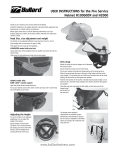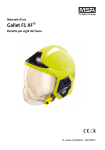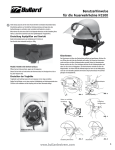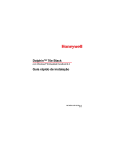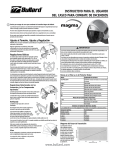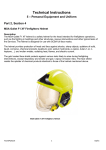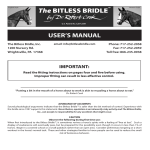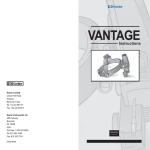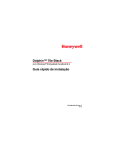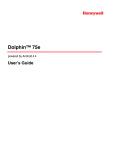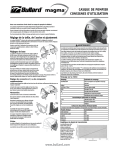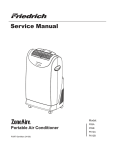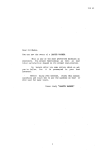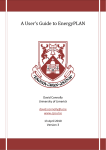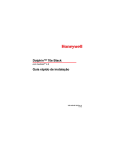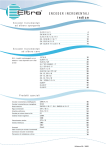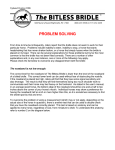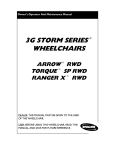Download User Manual - WFR Wholesale Fire and Rescue Ltd.
Transcript
FIRE HELMET USER INFORMATION GUIDE Thank you for choosing the Bullard Magma Fire Helmet. Head protection is an integral element of personal safety equipment that reduces the risk and helps prevent head injuries. Please read the following information to learn how to properly adjust your helmet. These instructions have been written with both your safety and comfort in mind. Do not use this helmet until you have read and understand the user information in this manual. Sizing, Fit and Adjustment MAGMA offers a wide range of adjustment features to create the proper fit for each user. Some are basic adjustments; some are related to the use of accessories and/or supplementary components. Head size 50-65cm, weight approx. 1.400g. WARNING Basic adjustments The ratchet system A allows adjusting the head size continuously to any size from 50-65 cm. To open the ratchet head ring, turn the ratchet knob counterclockwise. Put on A your helmet and turn the ratchet clockwise to a snug fit. B C Both front B and nape C band can be adjusted horizontally back and forth for proper balance and to fit very small and very big head sizes. D Same for proper fit of the eye protector. Adjust the front band B E backwards by relocating the snap fasteners to the designated position if more room is needed between the eyes and the eye protector. Both the crown straps D and the connection strap E adjust the helmet position vertically. The connection strap E can move the front part of the helmet up and down independently from the crown straps. Adjust by means of velcro strips to the desired position. Adjustments related to accessories and/or optional components The brow band B can be moved up to give enough room for wearing a face mask. The nape band C can be moved down to make the helmet tilt back permitting space for goggles. Chin strap B The red-black buckle A opens and closes the chin strap. Pressing the top of the red male part B to the outside opens the buckle. Cheek straps are adjusted with ladder locks C on both sides. Pull up the ladder lock to elongate the strap and pull the loose ends to shorten the straps. The chin strap is adjustable via a double D-ring D. C E The X-shaped neck straps E adjust with a single cam buckle to the left and are self balancing. C B A D This helmet complies with the retention requirements of EN443:2008 when the chin strap, supplied by the helmet manufacturer, is worn and adjusted in accordance with these instructions. Visor The integrated visor A and (optional) eye protector B should be pulled down completely while in use. A Protection is only provided in the fully deployed position. B Visors only provide limited protection against flying particles and are considered secondary eye protection. Always wear protective goggles when working with saws or devices used for cutting and extrication. Visors are not suitable for use at high ambient temperatures. Retract the visor to the stowed position during structural fire fighting. In extreme temperatures even the best visor materials lose their stability. Visors deformed due to thermal loads must be replaced immediately. The performance of your visor has been tested under the temperature range -40°C to 120°C. Components not being marked “T” should not be used under extreme temperature. Mesh visors are not suitable to protect against heat, flames, sparks, hazardous liquids, molten material or electricity. Damaged visors must be replaced. Marking visor and eye protector Marking EN14458:2004 Bullard R950 12 .+ = Explanation of marking European standard upon which marking is based manufacturer example for item number example for year of manufacturing suitable for fire fighting for general use rating as face protection rating as eye protection Optional characteristics and marking .-40°C suitable down to -40°C K abrasion resistance N anti-fog Contact with liquid chemicals The durability of the visor and adapters was tested with the following chemicals Chemical Concentration Sulfur dioxide 30% sodium hydroxide 10% p-Xylene undiluted butane- 1 -oL undiluted n-Heptane undiluted Diagram transmission factor The radiant heat protection provided by this visor varies with the temperature of the heat source as shown in this graph. The visor should only be used in situations where it can reduce the exposure of the wearer’s eyes to below 100 W/m². www.bullard.com Protective goggles A Fasten the goggles on the inner shell and adjust to the required contact with the face with the two loose ends of the strap A. To remove the goggles, pull the two side handles B forwards. C B Ear Neck protector (ENP) Make sure the ENP of your helmet is down and interfaces with your hood, SCBA, and coat collar to minimize gaps in protection during use. Cleaning and Storage Always keep your safety helmet clean. If necessary, clean it before you examine it. Do not use the helmet if it is still wet after use or cleaning. Retirement Criteria’s Outer shell Manual cleaning Do not use abrasive cleaners, benzine or solvents such as acetone, alcohol or similar to clean fire service helmets. The universal cleaning agent Secusept™ Cleaner (0.5-1.0% solvent) and the disinfectant Incidur as well as mild soapy water are approved. • Wipe helmet shell and all plastic parts of the interior lining with a damp cloth, then rub dry. • Clean the visor with lukewarm soapy water or alcohol-free glass cleaner, then rinse and wipe dry. • Remove straps and fabric of the interior lining then wash and disinfect together with the duty clothing in the wash bag. Machine cleaning Service Life and Mainenance/Assembly and Disassembly Even a slight collision or impact may compromise the structural integrity of the material without any direct visual evidence of damage. This also applies to thermal stresses. A thumb pressure check can be performed to check for existing damage: If the helmet shell can be deformed by a thumb press at the affected site, the strength of the helmet shell structure has been compromised. The helmet must be replaced and rendered unserviceable. Replace the following components, if one or more of the conditions listed below applies: Outer shell - cracks, dents or scratches with a depth greater than 1mm - any type of deformation Inner shell (inner liner) - changes in surface appearance, especially melted material WARNING 6 The length of your helmet’s service life is determined by the materials used in its construction as well as the environment in which the helmet is used and stored. This firefighting helmet with its painted helmet shell of high-strength and temperature-resistant composite exhibits excellent aging resistance and if undamaged it does not undergo any changes by sunlight (UV radiation). The life of the helmet is primarily limited by the effects of mechanical, thermal and chemical stresses. The composite used in your helmet is considered very resistant to these stresses. Furthermore, the helmet’s life is influenced by the amount and diligence of care and maintenance. The management of your fire department is responsible for deciding on the time for removing the helmet from service. Contact your local sales distributor or Bullard Europe directly if in doubt or to check your helmet. At regular intervals, conduct a check of the helmet shell, inner parts, straps and accessories. Visor The fire service helmet is subject to very strong mechanical loads during machine cleaning. It can be damaged if the following information is not observed. The helmet can be washed as follows in the washing machine. • Pack helmet in a padded wash bag (for wash bag see Bullard helmet accessories) • Load washing machine so that only one further helmet would fit into the drum • Preselect “swivel program” for respirators • Start wash • Rinse four times • Dry helmet thoroughly Cleaning agents: Approved cleaning agents: Eltra heavy-duty washing power with disinfecting properties, manufacturer: Ecolab Dosage: 5g Eltra per 1 L fresh water Water temperature: 62°C ± 2°C Storage: Store and transport your safety helmet so that it is protected against moisture, preferably in the original packaging. Life and Maintenance of your Bullard Fire Helmet - blistering, cracks, melted material spots - significant scratches - deformation - visor cannot be mounted securely in desired position; replace visor mount if necessary Protective edging (if this feature is included) - cracks, fraying, melted material; if applicable, glue loose protective edging back in place Reflective stripes - missing, burned or no longer reflective Chin strap and head bands - worn, missing or broken parts - damaged seams - worn hook-and-loop (Velcro) joints - worn, broken or missing clip closure - tears and wear - brittleness - discoloration Head ring - material embrittlement - cracked or broken - twist-lock is faulty Cover fabrics, neck protection Your helmet is designed to help absorb energy and impact. In addition, the helmet offers protection against flames, sparks, high temperature and liquid chemicals. The helmet can be damaged or even destroyed as it protects against these hazards. After a hard impact you should replace your helmet IMMEDIATELY, even if there is no visible damage on the outside of the helmet. It should also be replaced if the helmet has been exposed to extreme heat such as a flash-over. You should NEVER use a damaged helmet. It must be repaired – if possible – or be rendered unserviceable. - loose, cracked or frayed seams - fire damage, discoloration - cracks or perforation Screws - missing - check for tight seating of all screws Bullard recommends an annual inspection of your helmet by a trained specialist. After several years, destructive tests may be performed on a random sampling basis to check the protective properties of an inventory of helmets. www.bullard.com FIRE HELMET USER INFORMATION GUIDE Contact your local sales distributor or Bullard Europe regarding such testing. Assemble the inner liner R with the rear C and the front frame S and put it inside the shell. Mount crown A and connection straps Q to the assembly ring F and put the completed ring inside the helmet. Make sure it fits into the corresponding depressions of the inner liner. Leave the crown straps unhooked for the time being. Assembly and Disassembly for Maintenance Install the chin strap P with two screws to the right and to the left on the front sides, male part to the right, female part to the left side! Leave the rear part of the chin strap unhooked for the time being. Mount the eye protector M if existing. Install the sleeves L on both sides of the assembly ring F. Move the rear wings of the assembly ring F into the channel underneath the rear frame. Install the rear axis with the Bullard Logo J. Assemble the brow pad to the front band D & G and the ratchet cover to the nape band H. Assemble front D and nape band E to the assembly ring F and fix the snap fasteners. Hook in the rear part of the chin strap B to the rear frame C and mount the chin strap with screws O to the front frame S. R A Q E+H F D+G S T I+J W C L V U U V W O M B Assembly Accessories K P Ear Neck Protector Snap in the Ear Neck Protector first to the right and to the left front snap fastener, then to the rear side. Disassembly Assembly Use the Bullard Helmet Support for maintenance, easy handling, and to prevent scratching the helmet´s surface. Mount assembly V and cover plate W to the right and to the left of the outer shell X. The assembly plates are marked R(right) and L(left) which corresponds to the way the helmet is placed in front of you. Mount the washer U to the right and to the left. Marking is done as before. Put the visor T on the washer. Eye Protector Release one sleeve and mount the corresponding side of the eye protector under the sleeve. Repeat on the other side. Mask Adapter B Remove the cover plate and replace with the mask adaption plate. The mask adaption plate offers 3 different positions. Make sure you pick the right one for proper surface pressure of your specific mask. A A B Warranty Bullard provides a warranty for a 24 month period from the date of purchase in respect to manufacturing and material faults. The helmet will be repaired, replaced or credited at the discretion of Bullard. The helmet must be sent to us carriage free as a precondition for claiming warranty; it must not be modified and the damage must not have resulted from improper use. Bullard is not liable for damage, failure in use or other indirect, accidental, consequential or special costs, expenses or damages which could arise for the buyer, even if Bullard has been informed of the possibility of such damage. Bullard will not be held liable for damage that occurs during hot fire training. Use Bullard Nomex helmet covers for those helmets. NOTE: Do not remove the protective film before assembly is finished. www.bullard.com Warranty / Accessories and Replacement Parts Put the helmet upside down with the front side pointing to you. Use the Bullard Helmet Support for maintenance, easy handling, and to prevent scratching the helmet´s surface. Unhook the crown straps A and chin strap B from the rear frame. Disassemble front D and nape band E from the assembly ring and snap fasteners. Remove the ratchet cover H from the nape band and the brow pad G from the front band. Unscrew the rear axis I holding the Bullard Logo J. Move the rear wings of the assembly ring out of the channel underneath the rear frame C. Unscrew the sleeves K & L on both sides of the assembly ring and remove the eye protector M if installed. Uninstall the chin strap P by removing the two screws O to the right and to the left on the front side. Remove the assembly ring F. Remove crown A and connection straps Q. Take the inner liner R out and remove front S and rear frame C from the shock liner. Remove visor T and washer U. Unscrew assembly Y and cover plate W to the right and to the left of the outer shell. NOTE: NOTE: Make sure you lay out the rear straps flat and move the hangers in the same way. Hook in the crown straps to the rear frame. 7 Accessories and Replacement Parts When fitted with another item of personal protective equipment or with an accessory (other than as supplied by the helmet manufacturer for use with this helmet) a helmet marked as complying with EN443 might no longer satisfy all clauses of the standard. All accessories and replacement parts are designed for the use with your Bullard Magma helmet. Do not use them separately or with other brand or model helmets. Do not use any accessories or replacements parts other than listed below. R965 Plate Kit Assembly and cover plate R/L with screws R966 Connector Kit R967 Logo Kit R968 Chinstrap Kit Sleeve and washer R/L Bullard Logo with O-ring Chin strap with screws with screws and screw List of accessories and replacement parts R950Visor R957Napeband R958Browband R959 Brow Pad R160 Ratchet Cover R951 Eye Protector R960 Neck Protector R961 Dutch Neck Protector R952 Visor Gold Plated R992 Hanger Loop Han´n Go R993 Torch Bullard 2AA R994 Torch Bullard 2AAA R995 Chin Cup Strap R996 Nomex Hood R969 Crown strap kit R970 Mask Adapterkit R973 Screw kit Crown straps and connector strap with hangers Mask Adapter R/L with Complete set of screws screws Accessories and replacement parts are subject to technical changes and completion. Please check www.bullardextrem.com for latest information Colors Lumenescent Yellow, Yellow 1018, Fluorescent Yellow 1026, Fluorescent Red 2005, Red 3020, Green PMS 362, Blue 5015, White 9016, Black 9004, Silver 9006. Certification Your helmet has been tested and certified according to EN443:2008, visors according to EN14458:2004, goggles according to EN166 . The helmet is suitable for structural fire fighting and Hot Training. Hot Trainings can damage the helmet which is not covered by the regular warranty. It is recommended to provide separate helmets dedicated to Hot Training and use Nomex hoods. Options and Marking Option Marking Electrical properties classification - wet helmet insulation test according to 6.8.2 - surface insulation test according to 6.8.2 Classification Low temperature: -40°C C: Classification liquid chemicals E2 E3 **** NaOH, HCe, H2SO4, O-Xylen WARNING The Helmet absorbs the energy of a blow by partial destruction of, or damage to, the helmet. Even though such damage may not be readily apparent, any helmet subjected to a severe impact should be replaced. The protection provided by a helmet depends on the circumstances of an accident, and wearing a helmet cannot always prevent serious or even fatal injuries or long-term invalidity. The safety intended to be provided by the helmet can only be ensured when it is properly assembled and correctly fitted. Removable parts shall not be worn separately. Always wear a correctly-adjusted helmet and straps, and always bear in mind that a helmet cannot protect the neck area or other unprotected areas of the head. Ensure that wearing respiratory equipment does not affect the fit of the helmet and vice versa. This helmet is only approved for use in fire service, rescue service and disaster control operations. It is especially unsuitable as a sports or motorcycle helmet. Americas: E.D. Bullard Company 1898 Safety Way Cynthiana, KY 41031-9303 Toll free: 877-BULLARD (285-5273) Tel: 859-234-6616 Fax: 859-234-8987 www.bullard.com Europe: Bullard GmbH Lilienthalstrasse 12 53424 Remagen • Germany Tel: +49-2642 999980 Fax : +49-2642 9999829 www.bullardextrem.com Asia-Pacific: Bullard Asia Pacific Pte. Ltd. LHK Building 701, Sims Drive, #04-03 Singapore 387383 Tel: +65-6745-0556 Fax: +65-6745-5176 www.bullard.com 0299 Notified Body: 0299 FA PSA Prüf- und Zertifizierungsstelle Zwengenbergerstrasse 68 42781 Haan ISO 9001 certified ©2012 Bullard. All rights reserved. 6029009296C (0112)




